2010 INFINITI QX56 engine oil
[x] Cancel search: engine oilPage 3831 of 4210

TM-136
< SYMPTOM DIAGNOSIS >
SYSTEM SYMPTOM
41Slips/Will
Not En-
gage While accelerating in
5th, engine races or
slippage occurs.
ON vehicle
1. Fluid level and state
TM-148
2. Line pressure testTM-157
3. Accelerator pedal position sensor TM-71
4. CAN communication line LAN-4
5. Front brake solenoid valveTM-84
6. Control valve with TCMTM-172
OFF vehicle7. Torque converter
TM-172
8. Oil pump assemblyTM-172
9. Front brake (brake band)TM-172
10. Input clutchTM-172
11. Gear systemTM-172
12. High and low reverse clutchTM-172
42Slips at lock-up. ON vehicle1. Fluid level and state
TM-148
2. Line pressure testTM-157
3. Engine speed signal TM-53
4. Input speed sensorTM-48
5. Torque converter clutch solenoid valveTM-65
6. CAN communication line LAN-4
7. Control valve with TCMTM-172
OFF vehicle8. Torque converter
TM-1729. Oil pump assemblyTM-172
43No creep at all. ON vehicle
1. Fluid level and state
TM-148
2. Line pressure testTM-157
3. Accelerator pedal position sensor TM-71
4. Direct clutch solenoid valveTM-86
5. Transmission range switchTM-45
6. CAN communication line LAN-4
7. Control cable adjustmentTM-164
8. Control valve with TCMTM-172
OFF vehicle9. Torque converter
TM-172
10. Oil pump assemblyTM-172
11. 1st one-way clutchTM-172
12. Gear systemTM-172
13. Reverse brakeTM-172
14. Direct clutchTM-172
15. Forward one- way clutch (Parts behind drum support is
impossible to perform inspection by disassembly. Refer to
TM-8
, TM-9. TM-172
16. Forward brake (Parts behind drum support is impossible
to perform inspection by disassembly. Refer to
TM-8
, TM-9. TM-172
No. Items
Symptom Condition Diagnostic ItemReference
page
Revision: April 20092010 QX56
Page 3833 of 4210

TM-138
< SYMPTOM DIAGNOSIS >
SYSTEM SYMPTOM
48Others Shift point is low in “D”
position.
ON vehicle1. Output speed sensor and vehicle speed signal
TM-50
,
TM-76
2. Accelerator pedal position sensor TM-71
3. CAN communication line LAN-4
4. Control valve with TCMTM-172
49Judder occurs during
lock-up. ON vehicle1. Fluid level and state
TM-148
2. Engine speed signal TM-53
3. Input speed sensorTM-48
4. Output speed sensor and vehicle speed signalTM-50,
TM-76
5. Accelerator pedal position sensor TM-71
6. CAN communication line LAN-4
7. Torque converter clutch solenoid valveTM-65
8. Control valve with TCMTM-172
OFF vehicle 9. Torque converter TM-172
50Strange noise in “R”
position. ON vehicle
1. Fluid level and state
TM-148
2. Engine speed signal TM-53
3. CAN communication line LAN-4
4. Control valve with TCMTM-172
OFF vehicle5. Torque converter
TM-172
6. Oil pump assemblyTM-172
7. Gear systemTM-172
8. High and low reverse clutchTM-237
9. Reverse brakeTM-172
51Strange noise in “N”
position. ON vehicle
1. Fluid level and state
TM-148
2. Engine speed signal TM-53
3. CAN communication line LAN-4
4. Control valve with TCMTM-172
OFF vehicle5. Torque converter
TM-1726. Oil pump assemblyTM-172
7. Gear systemTM-172
52Strange noise in “D”
position. ON vehicle
1. Fluid level and state
TM-148
2. Engine speed signal TM-53
3. CAN communication line LAN-4
4. Control valve with TCMTM-172
OFF vehicle5. Torque converter
TM-172
6. Oil pump assemblyTM-172
7. Gear systemTM-172
8. Forward brake (Parts behind drum support is impossible to
perform inspection by disassembly. Refer to TM-8
, TM-9. TM-172
No. Items
Symptom Condition Diagnostic ItemReference
page
Revision: April 20092010 QX56
Page 3835 of 4210
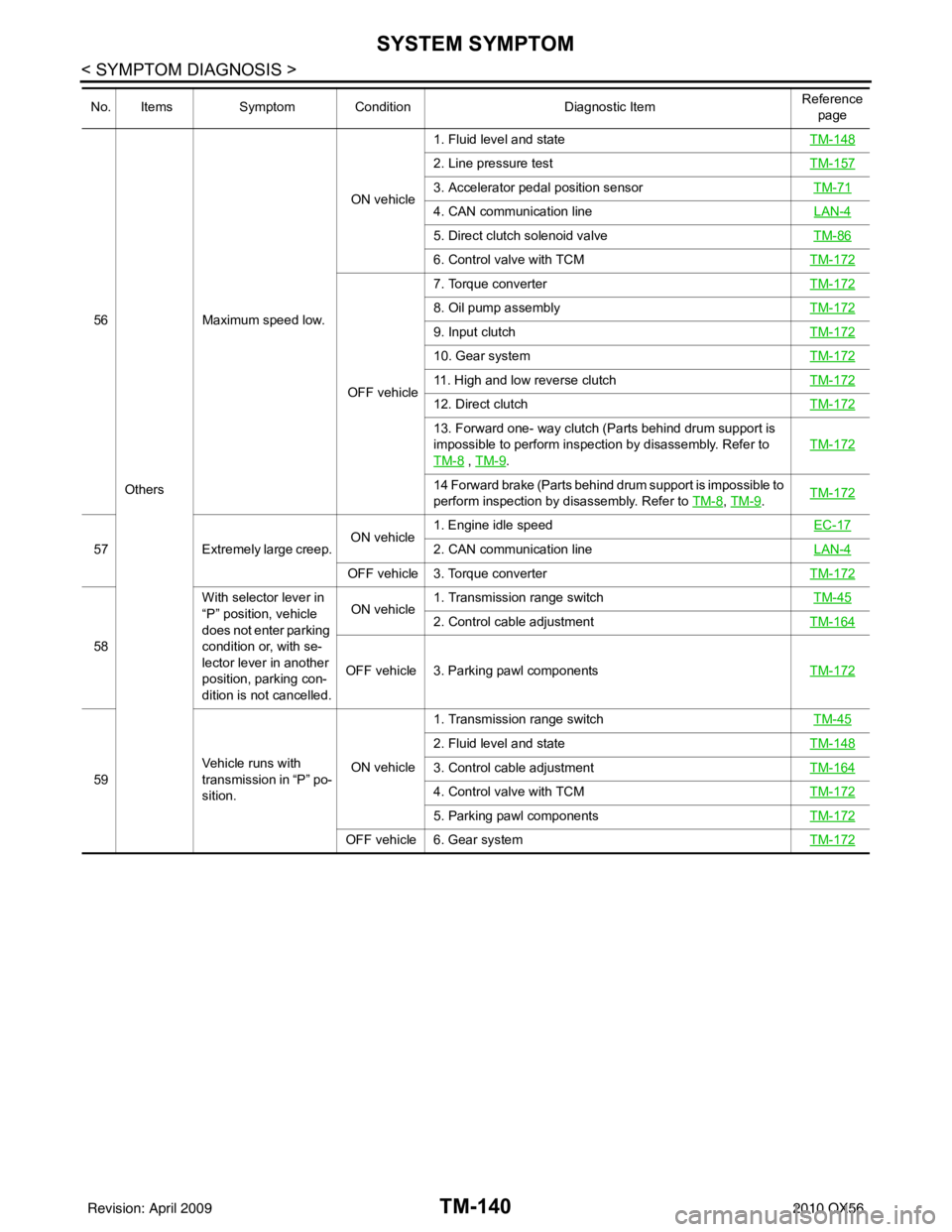
TM-140
< SYMPTOM DIAGNOSIS >
SYSTEM SYMPTOM
56Others Maximum speed low.
ON vehicle
1. Fluid level and state
TM-148
2. Line pressure testTM-157
3. Accelerator pedal position sensor TM-71
4. CAN communication line LAN-4
5. Direct clutch solenoid valveTM-86
6. Control valve with TCMTM-172
OFF vehicle7. Torque converter
TM-172
8. Oil pump assemblyTM-172
9. Input clutchTM-172
10. Gear systemTM-172
11. High and low reverse clutchTM-172
12. Direct clutchTM-172
13. Forward one- way clutch (Parts behind drum support is
impossible to perform inspection by disassembly. Refer to
TM-8
, TM-9. TM-172
14 Forward brake (Parts behind drum support is impossible to
perform inspection by disassembly. Refer to TM-8
,
TM-9. TM-172
57
Extremely large creep. ON vehicle1. Engine idle speed
EC-172. CAN communication lineLAN-4
OFF vehicle 3. Torque converter TM-172
58With selector lever in
“P” position, vehicle
does not enter parking
condition or, with se-
lector lever in another
position, parking con-
dition is not cancelled. ON vehicle
1. Transmission range switch
TM-45
2. Control cable adjustmentTM-164
OFF vehicle 3. Parking pawl components TM-172
59Vehicle runs with
transmission in “P” po-
sition. ON vehicle1. Transmission range switch
TM-45
2. Fluid level and stateTM-148
3. Control cable adjustmentTM-164
4. Control valve with TCMTM-172
5. Parking pawl componentsTM-172
OFF vehicle 6. Gear system TM-172
No. ItemsSymptom Condition Diagnostic ItemReference
page
Revision: April 20092010 QX56
Page 3845 of 4210
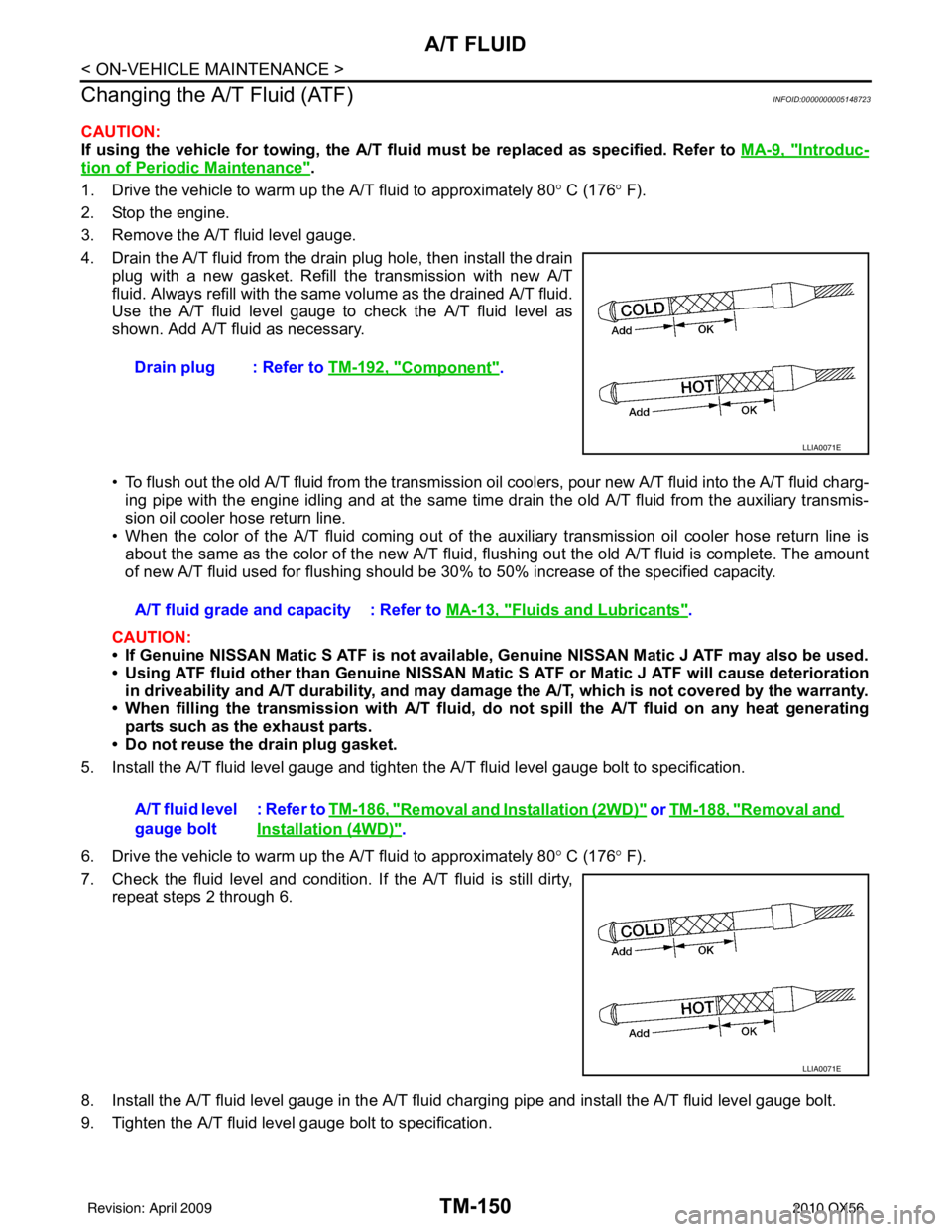
TM-150
< ON-VEHICLE MAINTENANCE >
A/T FLUID
Changing the A/T Fluid (ATF)
INFOID:0000000005148723
CAUTION:
If using the vehicle for towing, the A/T fl uid must be replaced as specified. Refer to MA-9, "
Introduc-
tion of Periodic Maintenance".
1. Drive the vehicle to warm up the A/T fluid to approximately 80 ° C (176 ° F).
2. Stop the engine.
3. Remove the A/T fluid level gauge.
4. Drain the A/T fluid from the drain plug hole, then install the drain plug with a new gasket. Refill the transmission with new A/T
fluid. Always refill with the same volume as the drained A/T fluid.
Use the A/T fluid level gauge to check the A/T fluid level as
shown. Add A/T fluid as necessary.
• To flush out the old A/T fluid from the transmission oil coolers, pour new A/T fluid into the A/T fluid charg-
ing pipe with the engine idling and at the same time drain the old A/T fluid from the auxiliary transmis-
sion oil cooler hose return line.
• When the color of the A/T fluid coming out of the auxiliary transmission oil cooler hose return line is
about the same as the color of the new A/T fluid, flushing out the old A/T fluid is complete. The amount
of new A/T fluid used for flushing should be 30% to 50% increase of the specified capacity.
CAUTION:
• If Genuine NISSAN Matic S ATF is not available, Genuine NISSAN Matic J ATF may also be used.
• Using ATF fluid other than Genuine NISSAN Matic S ATF or Matic J ATF will cause deterioration in driveability and A/T durability, and may damage the A/T, which is not covered by the warranty.
• When filling the transmission with A/T fluid, do not spill the A/T fluid on any heat generating
parts such as the exhaust parts.
• Do not reuse the drain plug gasket.
5. Install the A/T fluid level gauge and tighten the A/T fluid level gauge bolt to specification.
6. Drive the vehicle to warm up the A/T fluid to approximately 80 ° C (176 ° F).
7. Check the fluid level and condition. If the A/T fluid is still dirty, repeat steps 2 through 6.
8. Install the A/T fluid level gauge in the A/T fluid charging pipe and install the A/T fluid level gauge bolt.
9. Tighten the A/T fluid level gauge bolt to specification. Drain plug : Refer to
TM-192, "
Component".
LLIA0071E
A/T fluid grade and capacity : Refer to MA-13, "Fluids and Lubricants".
A/T fluid level
gauge bolt : Refer to TM-186, "
Removal and Installation (2WD)" or TM-188, "Removal and
Installation (4WD)".
LLIA0071E
Revision: April 20092010 QX56
Page 3850 of 4210
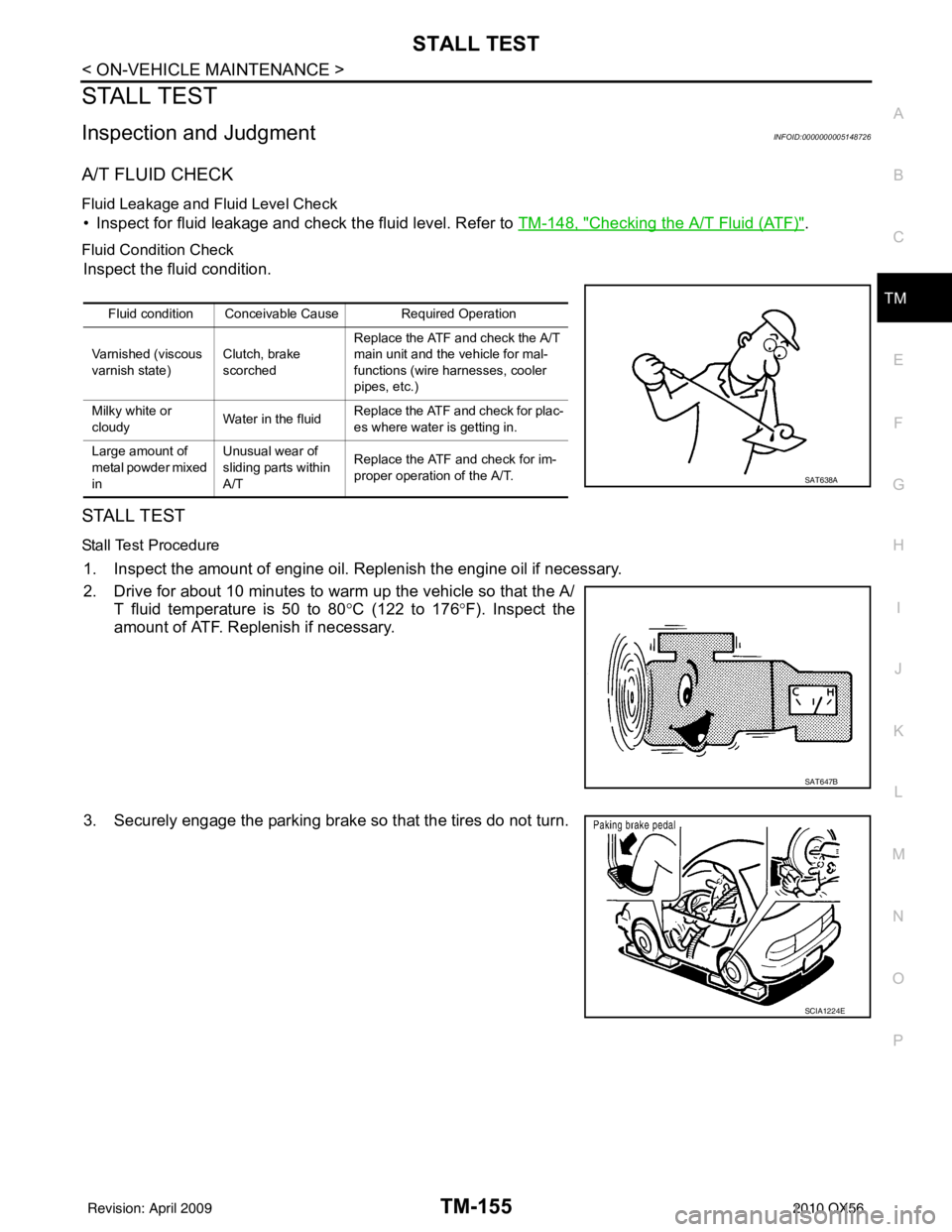
STALL TESTTM-155
< ON-VEHICLE MAINTENANCE >
CEF
G H
I
J
K L
M A
B
TM
N
O P
STALL TEST
Inspection and JudgmentINFOID:0000000005148726
A/T FLUID CHECK
Fluid Leakage and Fluid Level Check
• Inspect for fluid leakage and check the fluid level. Refer to TM-148, "Checking the A/T Fluid (ATF)".
Fluid Condition Check
Inspect the fluid condition.
STALL TEST
Stall Test Procedure
1. Inspect the amount of engine oil. Replenish the engine oil if necessary.
2. Drive for about 10 minutes to warm up the vehicle so that the A/
T fluid temperature is 50 to 80 °C (122 to 176 °F). Inspect the
amount of ATF. Replenish if necessary.
3. Securely engage the parking brake so that the tires do not turn.
Fluid condition Conceivable Cause Required Operation
Varnished (viscous
varnish state) Clutch, brake
scorchedReplace the ATF and check the A/T
main unit and the vehicle for mal-
functions (wire harnesses, cooler
pipes, etc.)
Milky white or
cloudy Water in the fluidReplace the ATF and check for plac-
es where water is getting in.
Large amount of
metal powder mixed
in Unusual wear of
sliding parts within
A/T
Replace the ATF and check for im-
proper operation of the A/T.
SAT638A
SAT647B
SCIA1224E
Revision: April 20092010 QX56
Page 3852 of 4210
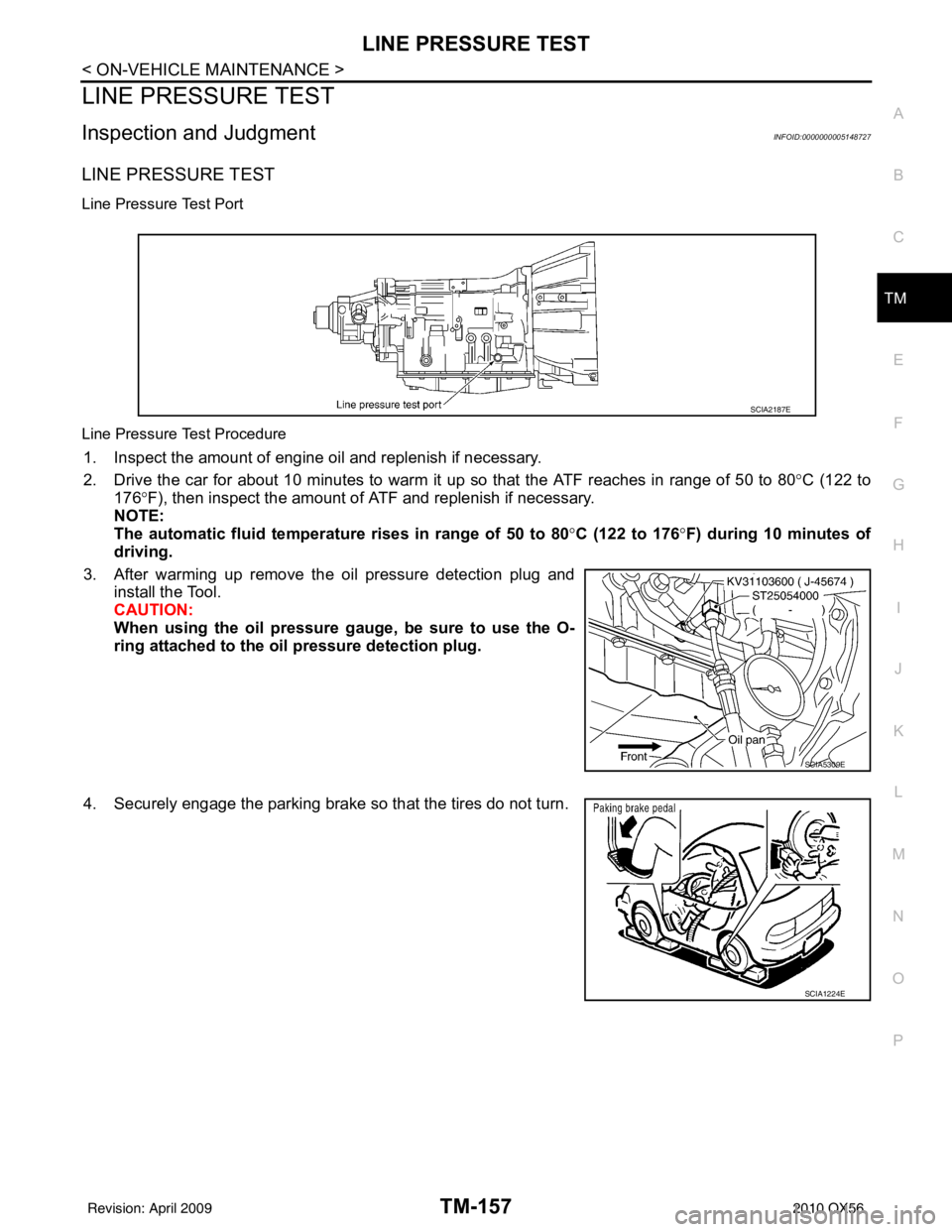
LINE PRESSURE TESTTM-157
< ON-VEHICLE MAINTENANCE >
CEF
G H
I
J
K L
M A
B
TM
N
O P
LINE PRESSURE TEST
Inspection and JudgmentINFOID:0000000005148727
LINE PRESSURE TEST
Line Pressure Test Port
Line Pressure Test Procedure
1. Inspect the amount of engine oil and replenish if necessary.
2. Drive the car for about 10 minutes to warm it up so that the ATF reaches in range of 50 to 80 °C (122 to
176° F), then inspect the amount of ATF and replenish if necessary.
NOTE:
The automatic fluid temperature rises in range of 50 to 80 °C (122 to 176° F) during 10 minutes of
driving.
3. After warming up remove the oil pressure detection plug and install the Tool.
CAUTION:
When using the oil pressure ga uge, be sure to use the O-
ring attached to the oil pressure detection plug.
4. Securely engage the parking brake so that the tires do not turn.
SCIA2187E
SCIA5309E
SCIA1224E
Revision: April 20092010 QX56
Page 3853 of 4210
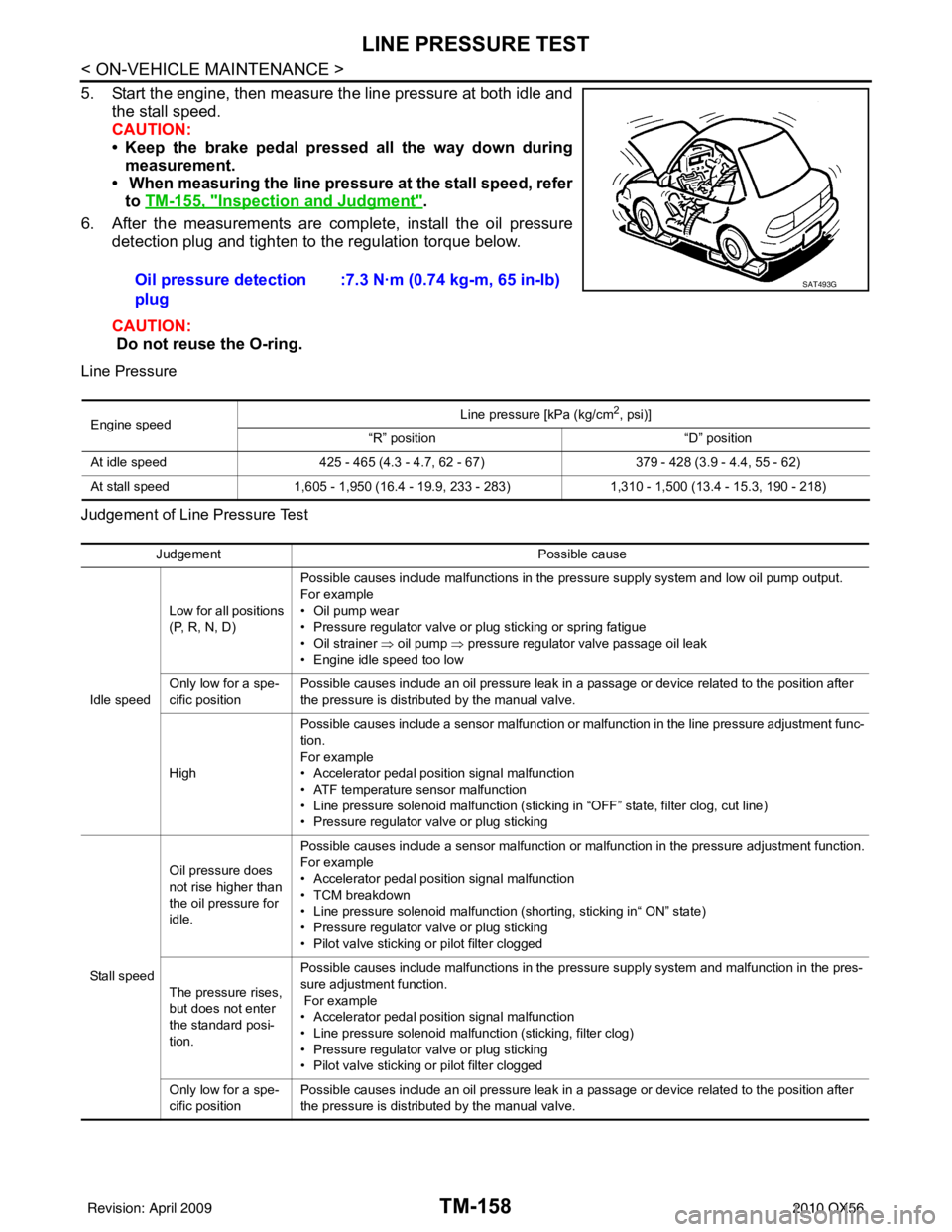
TM-158
< ON-VEHICLE MAINTENANCE >
LINE PRESSURE TEST
5. Start the engine, then measure the line pressure at both idle andthe stall speed.
CAUTION:
• Keep the brake pedal pressed all the way down duringmeasurement.
• When measuring the line pressure at the stall speed, refer
to TM-155, "
Inspection and Judgment".
6. After the measurements are complete, install the oil pressure detection plug and tighten to the regulation torque below.
CAUTION:
Do not reuse the O-ring.
Line Pressure
Judgement of Line Pressure Test
Oil pressure detection
plug :7.3 N·m (0.74 kg-m, 65 in-lb)SAT493G
Engine speed
Line pressure [kPa (kg/cm
2, psi)]
“R” position “D” position
At idle speed 425 - 465 (4.3 - 4.7, 62 - 67) 379 - 428 (3.9 - 4.4, 55 - 62)
At stall speed 1,605 - 1,950 (16.4 - 19.9, 233 - 283) 1,310 - 1,500 (13.4 - 15.3, 190 - 218)
Judgement Possible cause
Idle speed Low for all positions
(P, R, N, D)
Possible causes include malfunctions in the pressure supply system and low oil pump output.
For example
•Oil pump wear
• Pressure regulator valve or plug sticking or spring fatigue
• Oil strainer ⇒ oil pump
⇒ pressure regulator valve passage oil leak
• Engine idle speed too low
Only low for a spe-
cific position Possible causes include an oil pressure leak in a passage or device related to the position after
the pressure is distributed by the manual valve.
High Possible causes include a sensor malfunction or malfunction in the line pressure adjustment func-
tion.
For example
• Accelerator pedal position signal malfunction
• ATF temperature sensor malfunction
• Line pressure solenoid malfunction (sticking in “OFF” state, filter clog, cut line)
• Pressure regulator valve or plug sticking
Sta ll sp ee d Oil pressure does
not rise higher than
the oil pressure for
idle.
Possible causes include a sensor malfunction or malfunction in the pressure adjustment function.
For example
• Accelerator pedal position signal malfunction
• TCM breakdown
• Line pressure solenoid malfunction (shorting, sticking in“ ON” state)
• Pressure regulator valve or plug sticking
• Pilot valve sticking or pilot filter clogged
The pressure rises,
but does not enter
the standard posi-
tion. Possible causes include malfunctions in the pressure supply system and malfunction in the pres-
sure adjustment function.
For example
• Accelerator pedal position signal malfunction
• Line pressure solenoid malfunction (sticking, filter clog)
• Pressure regulator valve or plug sticking
• Pilot valve sticking or pilot filter clogged
Only low for a spe-
cific position Possible causes include an oil pressure leak in a passage or device related to the position after
the pressure is distributed by the manual valve.
Revision: April 20092010 QX56
Page 3855 of 4210
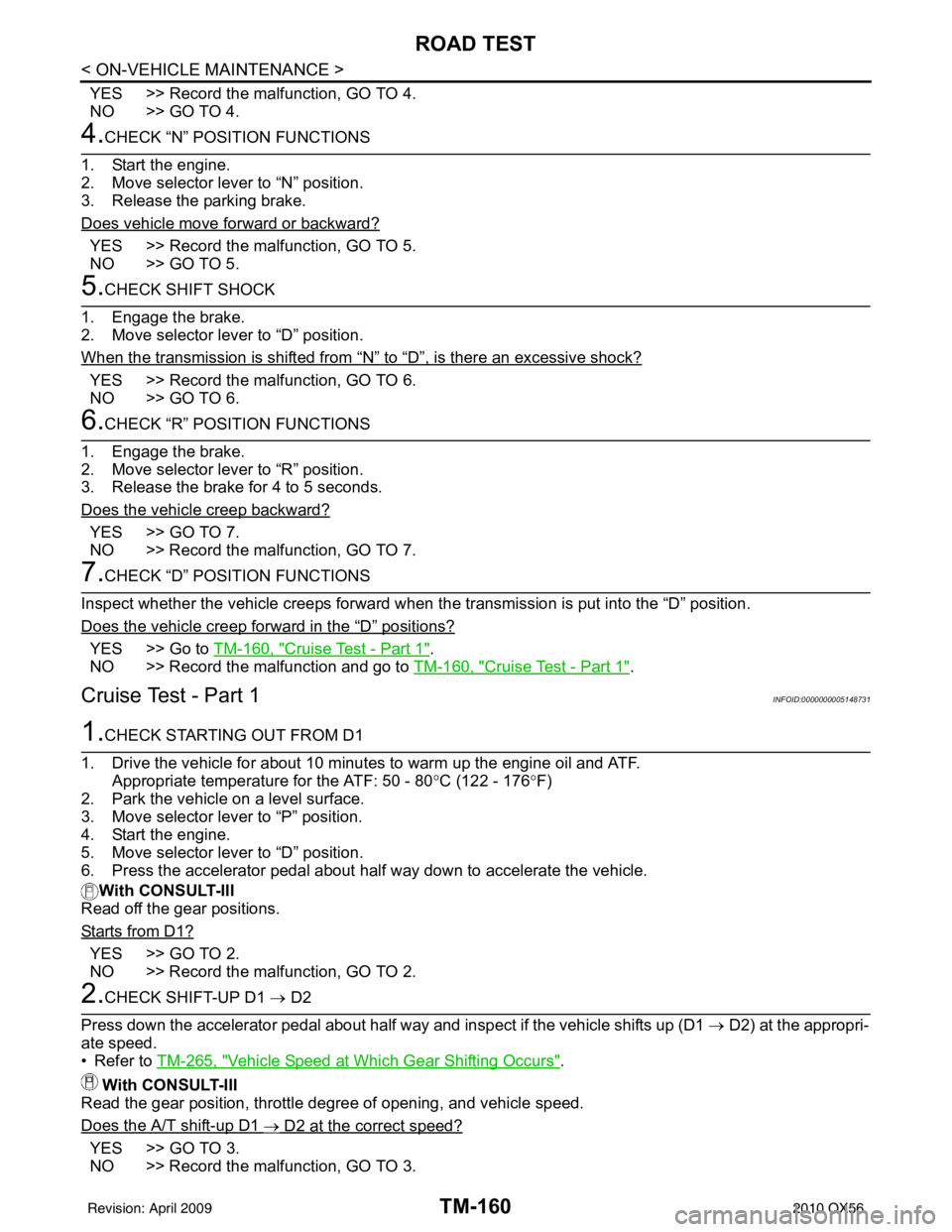
TM-160
< ON-VEHICLE MAINTENANCE >
ROAD TEST
YES >> Record the malfunction, GO TO 4.
NO >> GO TO 4.
4.CHECK “N” POSITION FUNCTIONS
1. Start the engine.
2. Move selector lever to “N” position.
3. Release the parking brake.
Does vehicle move forward or backward?
YES >> Record the malfunction, GO TO 5.
NO >> GO TO 5.
5.CHECK SHIFT SHOCK
1. Engage the brake.
2. Move selector lever to “D” position.
When the transmission is shifted from
“N” to “D”, is there an excessive shock?
YES >> Record the malfunction, GO TO 6.
NO >> GO TO 6.
6.CHECK “R” POSITION FUNCTIONS
1. Engage the brake.
2. Move selector lever to “R” position.
3. Release the brake for 4 to 5 seconds.
Does the vehicle creep backward?
YES >> GO TO 7.
NO >> Record the malfunction, GO TO 7.
7.CHECK “D” POSITION FUNCTIONS
Inspect whether the vehicle creeps forward when the transmission is put into the “D” position.
Does the vehicle creep forward in the
“D” positions?
YES >> Go to TM-160, "Cruise Test - Part 1".
NO >> Record the malfunction and go to TM-160, "
Cruise Test - Part 1".
Cruise Test - Part 1INFOID:0000000005148731
1.CHECK STARTING OUT FROM D1
1. Drive the vehicle for about 10 minutes to warm up the engine oil and ATF. Appropriate temperature for the ATF: 50 - 80° C (122 - 176°F)
2. Park the vehicle on a level surface.
3. Move selector lever to “P” position.
4. Start the engine.
5. Move selector lever to “D” position.
6. Press the accelerator pedal about half way down to accelerate the vehicle.
With CONSULT-III
Read off the gear positions.
Starts from D1?
YES >> GO TO 2.
NO >> Record the malfunction, GO TO 2.
2.CHECK SHIFT-UP D1 → D2
Press down the accelerator pedal about half way and inspect if the vehicle shifts up (D1 → D2) at the appropri-
ate speed.
• Refer to TM-265, "
Vehicle Speed at Which Gear Shifting Occurs".
With CONSULT-III
Read the gear position, throttle degree of opening, and vehicle speed.
Does the A/T shift-up D1
→ D2 at the correct speed?
YES >> GO TO 3.
NO >> Record the malfunction, GO TO 3.
Revision: April 20092010 QX56